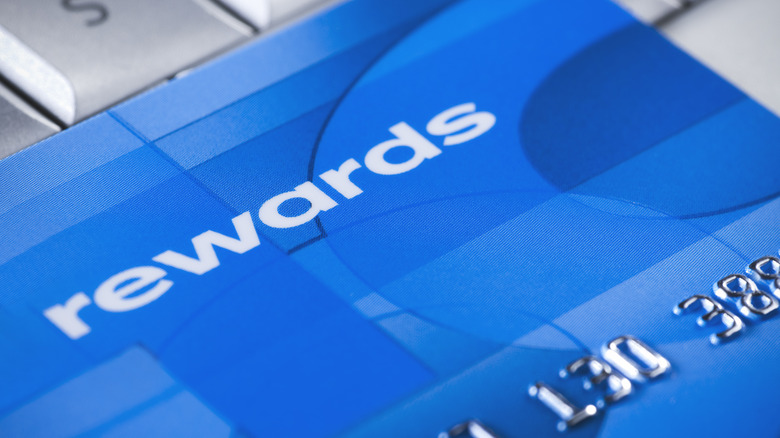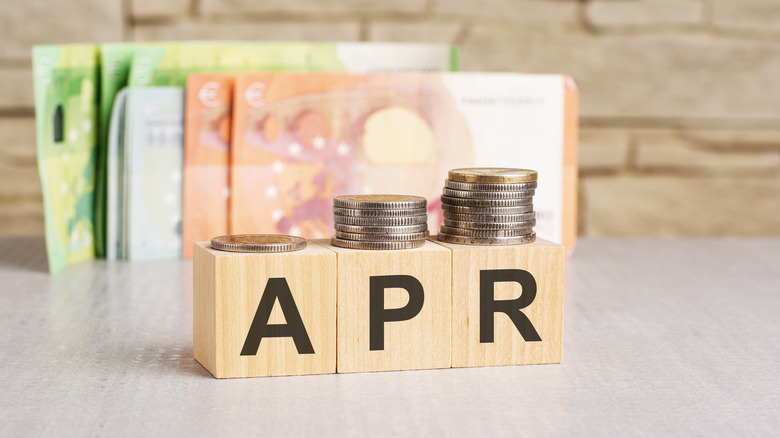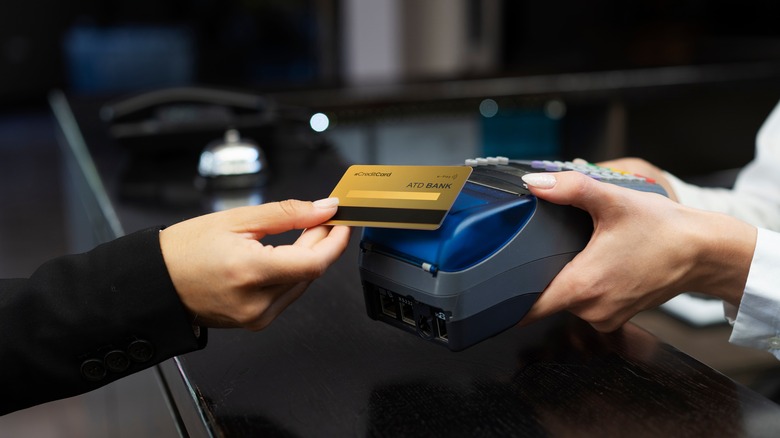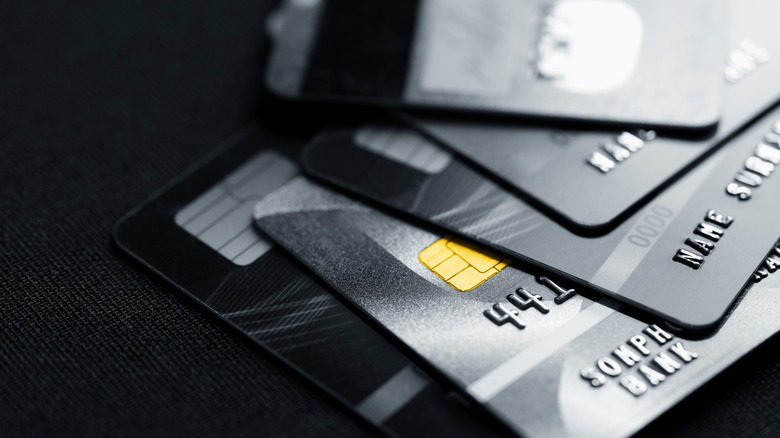The Dark Side Of Cash-Back Credit Cards
Cash-back credit cards have become one of the most popular credit options on the market. These types of credit cards are truly everywhere, offering all kinds of arrangements to provide a steady trickle of cash benefits to users. The practice dates back to 1986, with the introduction of the Discover card. Users spend money and earn rewards: It's a great bargain, considering that everyone is constantly pulling out their wallets to pay for something or other.
But there's a hidden, darker side to the world of cash-back credit cards that expertly flies under the radar. Card users often remain blissfully unaware of some of the more nuanced aspects of these programs. Cash-back has become a solid winner for card companies, financially, which might seem to run counter to the practice of dishing out cash back to their users. But the reality is that cash-back credit cards aren't what they seem. The offers act as cover to help credit card companies generate even more profit, though some users are still able to manage their way through these cards to enjoy the greatest volume of benefits. It all comes down to understanding how cash-back programs really work, and then enacting a strategy to distill only the benefits of these kinds of offers while avoiding any of the baggage that can sometimes come along with one.
Cash-back is worthless if you don't pay down the full balance every month
The first, and most important reality of the cash-back universe is that a card that offers rewards of any kind is utterly worthless if the full balance isn't paid down every month. Interest rates on borrowed money can erode an otherwise well-developed financial plan, and the same is true for cash-back credit card usage. The average American spends over $6,000 per month, all told (including housing, car payments, and the like). If half goes on a credit card, there's the potential to introduce a not insubstantial stream of rewards cash back into the typical credit card account. But the interest on $3,000 or even just a part of that monthly outgoing figure will be enough to wipe away any positive momentum that cash-back offers provide.
The truth is that these types of programs act as a small incentive to use one card over another, but the only way to extract value from that capital is by eliminating any negative drain on the account at the same time. Otherwise, the cash-back rewards will only be overshadowed by additional charges on the account borne specifically through those efforts to accrue them.
And poorer Americans functionally subsidize the program for higher earners
The meat and potatoes of the cash-back credit card industry surround the manner by which it can effectively run. The reality is that poorer Americans functionally subsidize the system for those who are in a position to take advantage of the benefits — typically higher earners and those who are wealthier in general.
There are two ways that this works. First of all, when you swipe your card at any merchant's register, the business pays an interchange fee to the card issuer. This is a few cents on the dollar, but that really adds up when taken as a whole. The slice of businesses' profits that goes to card companies incentivizes them to raise prices to meet the shortfall. This might only be an increase of a few percent, but the inflation is seen across the board rather than on specifically targeted products. Cash buyers — often those who aren't eligible for or financially stable enough to use credit cards — pay this inflated price, too, making their dollar less valuable.
Also, with higher interest rates being levied against those with lower credit scores, those in worse financial positions must pay more to use their cards in the event that they carry over a balance. The interchange fees and higher interest earnings allow card issuers to extend these kinds of programs in the first place, putting the burden firmly on the backs of those in the greatest positions of vulnerability.
High value reward categories are often capped
Rewards credit cards draw in countless new signups by way of inflated incentive categories. Often, you'll find a credit card that offers as much as 5% cash-back rewards on certain spending areas, like at Amazon, or on hotels and restaurants. The big flashy earnings numbers will draw in new customers in droves. But the high-value reward categories typically find themselves capped at a certain earnings amount. For instance, Discover's More card rewards users with a beefy 5% return on travel and restaurant purchases, but the reward dollars max out at just $40 with the eligible spending cap set at $800. That's conceivably the bill for just one weekend of travel for you and your loved ones, rendering the card useless for the remainder of your vacation planning for the year.
Citi Platinum Select cards also impose limits, capping rewards accumulation at $300 per year. If you're in the market for a new credit card, it's absolutely essential to read through the fine print to discover any roadblocks to your intended use of the rewards program. If there are significant hindrances, continuing the search for a card that aligns with your needs is likely the best avenue.
Introductory bonuses tend to entice wanton spending
Unfortunately, the need to strike a balance between spending and a solid payoff strategy can easily be negated in the first few months of owning a new cash-back credit card. These cards often include introductory offers that entice users to overspend. If you're opening a new card in advance of a pre-budgeted home renovation or big family trip, the introductory offer of excess cash-back or some other reward benefit can make a big impact. However, the race to accumulate a preordained spending figure with your everyday finances can lead to wanton spending that eventually wipes out any rewards you may have been spending to earn.
These early offers are designed deliberately to passively persuade users to overspend. That way, the interest rates charged on any money owed on the card balance overshadow the enlarged benefits that card companies promise to their new users. If you're applying for new cash-back rewards cards, make sure you have a clear path to both spending the money required to earn the introductory offer and paying it back so that you can take advantage of the whole benefit.
Many cash-back cards are marked by higher than average APRs
Once again, interest rates come into the picture when discussing cash-back card options. To compensate for the outgoing flow of cash that would otherwise cut into a credit card company's profits, the interest rates that users are charged often see a slight inflation over the standard line of credit. In reality, this is a feature that's essential to keep in mind, but one that will only play a role in your financial calculations if you overspend on the card.
The most important feature of a credit card usage strategy is getting the payoff right. If you pay down your balance in full every month, added interest charges will never factor into your budget. Even so, this is easier said than done for just about everyone. A card with a higher interest rate will always be a riskier financial product to use than one with a low rate — or cash, carrying no added interest charges.
Rewards cards may carry an annual fee, reducing or totally wiping out accrued incentives
Some rewards cards may offer excellent cash-back offers or point redemption options, but carry an annual fee. Annual fees may not be a big deal for some users because the additional perks of the card make up for the added cost. A travel rewards card, for instance, might offer free checked bags with every flight, making the annual fee a different way to pay for bags — or virtually negate it for a frequent traveler.
However, the average cash-back cardholder earned just $278 in cash-back in 2021. This is a nice infusion of cash, but if you're earning those rewards on a card that charges a $300 annual fee then you're actually in the red when calculating all of the card's facets. A pure cash-back card therefore tends to be a poor bargain if it comes with this added fee structure. Other rewards cards may be able to bulk up the benefits to justify added costs, but with a cash-back card, the only ones you should be considering are those without added fees that come along simply with ownership.
Points and cash-back credits often come with redemption minimums and restrictions
Earning rewards brings a great feeling to users looking ahead to the things that might be redeemed with the cash or through points. A big purchase might be cut down to size with cash-back credits, or a savings goal may be attainable with a little extra speed. But rewards earnings sometimes come with caveats that hamstring the ways in which you can take advantage of them.
You may only be able to withdraw rewards from the credit account's piggy bank in intervals of $25 or perhaps 500 points (converting to some cash value). This means that any excess — even if that's say, $24.50 — may not be redeemable until you go back to using the card to build up more rewards. Finding out about redemption rules as you prepare to cash in on your earned rewards is a real drag. This strategy is just another tactic that credit card companies use to keep their customers coming back to their card over others. If you have to wrack up another few dozen transactions to reach your next redemption threshold, you're incentivized to keep spending on that cash-back credit card rather than using another payment method.
Many cash-back cards carry foreign transaction fees
While credit card companies often stylize travel rewards cards and pure cash-back cards as sort of "siblings," the reality is that travel cards typically eliminate foreign transaction fees for the user. The need for this is built right into the product, but the same can't be said for all cash-back credit cards. Cash rewards options may or may not come with foreign transaction fees added to card user agreements, but they certainly aren't eliminated as an overall standard. As with many other features of the cash-back landscape, any fees or additional charges you have to pay result in a weaker overall benefit when it comes time to enjoy the rewards.
Selecting a cash-back credit card that doesn't carry any foreign transaction fees is an important step for any card user. However, it's particularly valuable for those who tend to travel more frequently. Losing additional value on every transaction made outside the United States can add up to a real deal breaker for some people. Even if you've never been outside the country, avoiding this hurdle will keep your options open for future opportunities.
The best rewards programs naturally require higher credit scores
As with all things credit, the better your credit score the better the offers available to you will be. It can be difficult to quantify exactly how much changes in credit scores affect interest rates, card options, and other benefits. But suffice it to say, the best cards available are only offered to those with strong existing track records in this realm.
Interest rates are among the most important features that change with credit scores. But the best cards themselves are often off-limits to those with average scores or even a score breaking into the good category. Many cards that are available for those with average or fair scores won't provide any benefit in the form of an introductory APR offer, either. This means that the 0% interest rate that can be found for the first year or more is reserved solely for those with existing credit steadiness. The practice is obviously one that protects credit card companies from defaults by users who haven't shown the best management in the past, but it also hurts first-time users who haven't had an opportunity to build a strong credit history.
Some cash-back cards include expiration terms hidden in the fine print
Expiration of rewards is a reality in the cash-back and rewards card world. It's possible to forfeit your accrued benefits by missing a payment or if you don't use the card for an extended period of time. Keeping users interested in the product is a primary feature of any business, and the same goes for credit card issuers. However, once you've successfully applied for a card, there aren't many carrots that can be used to incentivize you to stick around. Instead, credit card companies sometimes rely on negative outcomes to keep you pulling out their plastic rectangle instead of someone else's. Expiration terms will be buried deep in the fine print of your cardholder agreement, so scouring the document for any kind of language regarding forfeiture of points, dollars, or other rewards is a must — ideally before opening an account.
Losing out on built-up rewards is also commonly seen when closing an account. Credit card companies don't automatically hand over any leftover benefits you have sitting in your account when you begin the process of closing it out. Instead, you'll need to use them first to take advantage of your full cash-back earnings.
Card issuers have subverted the narrative, creating a fear of missing out on those precious extra cents
At the end of the day, the world of cash-back credit cards is a murky one. Card companies have successfully created a consumer culture in which people from all walks of life are constantly hunting for opportunities to earn some kind of advantage while going through their daily routines. Cash-back credit cards make for a tangible way to see those rewards add up, and it leads many to relentlessly chase after all the additional dollars and cents they can. Unfortunately, this is sometimes to the detriment of the user, since these cards incentivize overspending and can easily be more costly to own than a traditional credit card.
Cash-back cards can act as a fantastic addition to your wallet. But diligent budgeting and intelligent spending habits must govern their use at all times. Otherwise, the trickle of benefits that come in through the use of the card will virtually always be negated by poor credit management practices that see added fees, interest charges, and other penalties erode the value of those precious few cents that kick back into the account after a transaction. Stay smart with your credit usage, and you'll always enjoy the small boost that cash-back rewards can provide.











